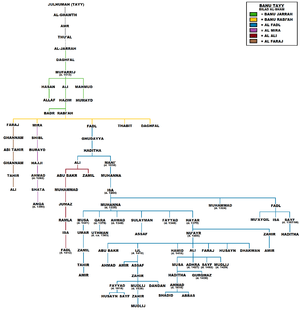Fadl ibn Rabi'ah
Abu Imran Fadl ibn Rabi'ah[note 1] was an Arab emir in Syria in the early 12th century. Most of what is known of him centers on his military activities in circa 1107. He was the ancestor of the Al Fadl dynasty, which ruled the Bedouin tribes of the Syrian desert and steppe between the 12th and 18th centuries.
| Fadl ibn Rabi'ah | |
|---|---|
| Born | Abū Imrān Fadl ibn Rābi'ah Mecca |
| Died | Syria |
| Burial | |
Biography

Fadl was a son of Rabi'ah ibn Hazim, a great-grandson of Mufarrij ibn Daghfal, the Jarrahid ruler of Palestine in the late 10th and early 11th centuries.[2] The Jarrahids were part of the much larger Banu Tayy tribe. His father Rabi'ah was aligned with Seljuks.[3] But later Fadl quarreled with the Burid ruler of Damascus, Toghtekin, who expelled him from Syria in 1107/08.[1][3] Afterward, he sought refuge with and formed a pact with Sadaqa,[1][3] the Mazyadid ruler of Hillah south of Baghdad.[3]
When Sadaqa challenged the Seljuk sultan in Baghdad, Fadl at first fought alongside him in the vanguard, but then defected to the Seljuks.[1] Upon his arrival in Baghdad, he and his tribesmen were rewarded and given lodging at Sadaqa's former Baghdad residence.[1] Fadl sought to cut off Sadaqa's desert route toward Syria and asked permission to pursue his strategy.[1] The Seljuks gave Fadl their blessing, but once he crossed the Euphrates river in Anbar, nothing is known of his fate.[1][3]
Legacy
Fadl was the father of a certain Ghudayya,[2] and the ancestor of his namesake tribe, the Al Fadl,[2][4] whose emirs and descendants ruled the Bedouin of the Syrian desert and steppe on behalf of the Ayyubids, Mamluks,[2] and early Ottomans until at least the early 17th century.[5] Later, part of Fadl's descendants became known as Al Abu Risha,[5] and took over the leadership of the Mawali tribe, and continued to serve as the hereditary leaders of the Bedouin in the Syrian Desert until the invasion of Anaza tribesmen from Najd in the 18th century.[6] The other part of Al Fadl migrated to the Golan Heights and Beqaa Valley,[7] where they eventually abandoned their nomadic way of life and adopted farming, and have continued to go by the name of Al Fadl. They were displaced from the Golan Heights after the Israeli occupation in the 1967 Six-Day War and have since lived in the vicinity of Damascus.[8]
Notes
References
- Richards, D. S. (2010). The Chronicle of Ibn Al-Athir for the Crusading Period from Al-Kamil Fi'L-Ta'Rikh.: The Years 491-541/1097-1146 the Coming of the Franks and the Muslim Response. Ashgate Publishing. p. 126.
- Hiyari, Mustafa A. (1975). "The Origins and Development of the Amīrate of the Arabs during the Seventh/Thirteenth and Eighth/Fourteenth Centuries". Bulletin of the School of Oriental and African Studies. 38 (3): 513. doi:10.1017/s0041977x00048060. JSTOR 613705.
- Canard, Marius (1991) [1965]. "D̲j̲arrāḥids". In Lewis, B.; Pellat, Ch.; Schacht, J. (eds.). The Encyclopedia of Islam. II: C–G (new ed.). Leiden and New York: Brill. p. 484. ISBN 90-04-07026-5.
- Tritton, A. S. (1948). "The Tribes of Syria in the Fourteenth and Fifteenth Centuries". Bulletin of the School of Oriental and African Studies. 12 (3/4): 567. doi:10.1017/s0041977x00083129. JSTOR 608712.
- Bakhit, Muhammad Adnan (1982). The Ottoman Province of Damascus in the Sixteenth Century. Librairie du Liban. p. 201.
- Masters, Bruce (2009). "Mawali Bedouin Confederation". In Agoston, Gabor; Masters, Bruce (eds.). Encyclopedia of the Ottoman Empire. New York: Facts On File, Inc. pp. 353–354.
- Chatty, Dawn. "Land, Leaders and Limousines: Political and Moral Authority". Oxford University. p. 392. Retrieved 2016-05-08.
- Jassem, Zaidan Ali (1993). Impact of the Arab-Israeli Wars on Language & Social Change in the Arab World: The Case of Syrian Arabic. Pustaka Antara. p. 18.